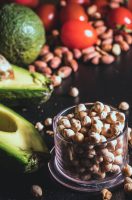What is Celiac Disease?
Celiac disease, also referred to as celiac sprue, nontropical sprue or gluten sensitivie enteropathy, is caused by the body’s inability to properly digest foods that contain gluten. Gluten is found in a variety of grains including wheat, barley, rye, and sometimes oats. When a person with celiac disease eats a food that contains gluten, the protein from the gluten sets off an autoimmune response, which damages the villi in the small intestines. 6
Individuals with celiac disease are likely to become malnourished due to the fact that their bodies do not properly absorb necessary nutrients such as: folic acid, iron, and sometimes serum calcium, B-12, vitamin D, and E. 3,5
It is estimated that 1 out of every 133 people have celiac disease, some may not experience or exhibit any symptoms while others may suffer from bouts of diarrhea or constipation, bloating, abdominal cramping, anemia or tan/gray fatty stools, weight loss, and abdominal distention. Unfortunately these symptoms are often mistaken for Irritable Bowel Syndrome or a variety of other problems. 6 It is also important to note that there are a large number of other diseases and or conditions associated with celiac disease. Some conditions may coexist or simply mimic celiac disease. 3
Celiac disease is genetic and often diagnosed early in childhood; however, it may present itself later on in years. Anyone with a family history or symptoms of celiac disease should consult their practitioner for a thorough exam and proper testing. 6
Left undiagnosed or untreated, celiac disease may lead to more severe or long-term complications such as, osteoporosis, infertility, birth defects and even cancer. 6
3 Key Nutrients:
- Iron
- Folic acid
- B-12
Iron is vital to the human body. It transports oxygen from the lungs to the body’s tissues and carbon dioxide from the tissues to the lungs. Iron deficiency may lead to learning disabilities (especially in developing children), impaired immune function, decreased energy levels and anemia. Heme iron (found in animal products) is the most efficiently absorbed iron. Non-heme iron is plant-based iron that is poorly absorbed in the body. The RDA for iron is 10 milligrams for males and 15 milligrams for females. Meal-plan analysis shows a daily iron intake from food at 10 mg, adequate for males however, additional supplementation of 5 mg is need for females.
Food Sources of Iron
(Milligrams per serving)
- Clams= 23.8
- Sirloin steak= 2.9
- Shrimp= 2.6
- Soybeans= 8.8
- Quinoa= 5.3, 1c
- Swiss Chard= 4.0 1c
- Black beans= 3.6 1c
- Potato= 2.8
- Apricots, dried= 2.0
Folate is also known as folacin. Folate and B-12 function together in a variety of body processes. Without folate cells do not divide properly, most affected is the gastrointestinal and genital tract. Deficiencies of folic acid in pregnant women may lead to birth defects such as spina bifida. Rich sources of folate can be found in a wide variety of plant foods and is sensitive to heat, and light. Alcohol, and prescription drugs also impair it. The RDA for folate is 200 micrograms for males and 180 micrograms for females, and can be supplemented in capsule form if needed.
Food Sources of Folate
(Milligrams per 100 grams (3 1/2 oz) edible portion)
- Brewer’s yeast= 2,022
- Black-eyed peas= 440
- Rice germ=305
- Beef liver= 295
- Wheat bran= 195
- Soy beans= 225
- Asparagus= 110
- Walnuts= 77
- Kale= 70
B-12 also known as cobalamin, works with folate in the synthesis of DNA. B-12 reactivates folate, therefore a deficiency of B-12 will likely result in a deficiency of folate. B-12 deficiency is very common among the elderly and may be mistaken for dementia. Other symptoms of B-12 deficiency include; numbness in the extremities, depression, and anemia. The RDA of B-12 is 2.0 micrograms and can be found in animal foods. Sublingual supplementation in the form of metylcobalamin is recommended for individuals with digestive disorders. 1,4
Food Sources of B-12
(Milligrams per 100 grams (3 1/2 oz) edible portion)
- Liver, lamb= 104.0
- Liver, beef= 80.0
- Sardines= 17.8
- Salmon= 5.0
- Eggs= 2.0
- Swiss cheese= 1.8
- Cottage cheese= 1.0
- Halibut= 1.0
- Swordfish= 1.0
Additional Foods, Herbs and Supplements for Celiac Disease
Vitamin A
- All organs with which there is tissue turnover rely on Vitamin A. It is also very important in immune function, and bone growth.
- The therapeutic range is 5000 IU for adult males, 4000 IU for adult females.
- Animal liver (preferably organic) is an excellent source of Vitamin A as well as chili peppers and dandelion greens.
Vitamin D
- More of a hormone due to its action. It regulates calcium and phosphorus absorption in the intestines.
- RDA- 2000 IU daily-although best obtained through sunlight.
- Vitamin D is fat-soluble. Sources of good fats in the diet would include, wild salmon and mackerel, cod liver oil and leafy green vegetables.
Vitamin E
- Plays an active role in protecting and increasing vitamin A storage.
- Absorption occurs in the cells of the intestinal mucosa.
- Found in plant foods such as olives, and the oils of nuts and seeds.
- Therapeutic consideration for vitamin E is 100 to 1,200 IU per day.
Vitamin K
- Aids in the formation of bone protein and clotting factors.
- Absorbed in the upper two-thirds of the small intestines.
- Therapeutic doses of vitamin K range from 100-500 mcg/day.
Probiotics
- Restores micro floral balance and permeability to the intestines.
- Improves infantile diarrhea.
Resources:
1 The Encyclopedia of Healing Foods M. Murray N.D. 2005
2 Clinical Nutrition A Functional Approach 2nd Edition 2004
3 Therapeutic Nutrition Part One Ed Bauman, M.Ed., Ph.D. & Jodi Friedlander, N.C
4 The Clinicians’ Handbook of Natural Medicine Second Edition 2008
5 Collin, P., Kaukien, K., Valimaki, M., & Salmi, J. (2002) Endocrinological disorders and celiac disease. Endocrin Reviews 23 (40: 464-483. Retrieved from http://edrv.endojournals.org
6 Digestive Wellness by Elizabeth Lipski, Ph.D., CCN (2005)




